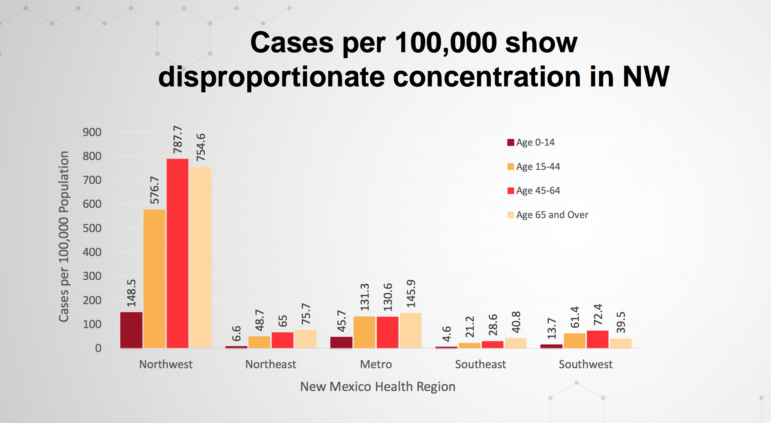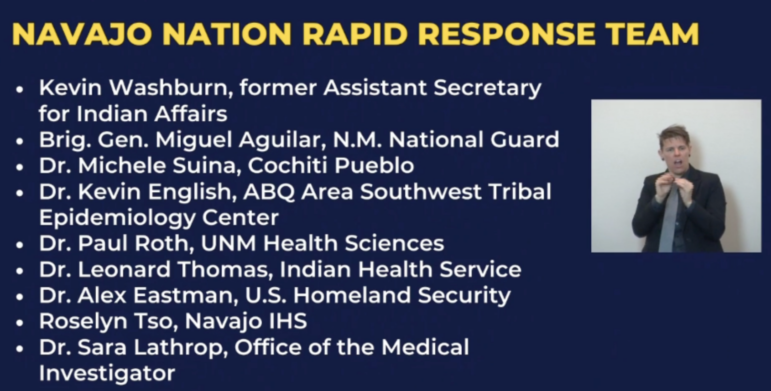
Gov. Michelle Lujan Grisham took baby-steps to reopen New Mexico’s economy Thursday, allowing non-essential retailers to provide curbside and by-appointment services, opening golf courses and making state parks available for day use starting Friday.
But the new order sidesteps the state’s epicenter of COVID-19 — New Mexico’s northwest corner. Earlier in the day Thursday, the mayor of Gallup sent a letter pleading with the governor to declare a state of emergency in the city, which accounts for just 3.5% of New Mexico’s population but 30% of the state’s COVID-19 cases.
“Our community is unable to adequately address the outbreak without the imposition of certain restrictions necessary to regulate social distancing, public gatherings, sales of goods, and the use of public streets,” Mayor Jackie McKinney wrote. Navajo Nation President Jonathan Nez “fully supports the request and is hopeful that it will help to prevent Navajo people from traveling to the border town,” said a daily press release from his office.
Indeed, a New Mexico COVID-19 modeling report available on the Department of Health website, dated Tuesday, notes the “NW region has the highest growth rate; week-over-week improvement is leveling off indicating additional actions are critical.”
The new public order announcing some loosening of the economic shutdown across the state specifically excludes McKinley, San Juan and Cibola counties. And, the governor said Thursday those counties would likely see more restrictions. She did not give details, but said they were being worked on. During Thursday’s update Lujan Grisham announced a Navajo Nation Rapid Response Team, an acknowledgement of the severity of the situation.

In McKinley County, 79% of the population is Native American, most members of the Navajo Nation. The county’s large outbreak is a significant reason Native Americans compose 52% of New Mexico’s COVID-19 cases, while only representing 11% of the state’s population.
On a separate call earlier in the day Thursday, Dr. Loretta Christensen, Chief Medical Officer, Navajo Area Office at the Indian Health Service, said cases would continue to rise on the Navajo Nation, with the peak occurring around May 10 — a date Dr. David Scrase said he’d love to see during Lujan Grisham’s online update Thursday afternoon.
“I’d love it, I’d be so happy, if it were on May 10,” said Scrase, who is Lujan Grisham’s secretary of the New Mexico Human Service Department.
Scrase suspected the growth could continue into June, he said, although he acknowledged the state of New Mexico doesn’t have sufficient data to project when the peak would happen.
The situation in McKinley County is grim. With a population of about 71,000, the mostly rural county has more positive COVID-19 cases (1,027) than the state’s largest county, Bernalillo (812). Bernalillo County, with around 680,000 people, is nearly ten times larger.
All 14 intensive care beds in McKinley county are now full, Scrase said, and patients are being transferred to larger hospitals in Albuquerque, with 40 transferred last week, and so far, 30 this week. Normal ICU bed capacity in Albuquerque hospitals is now maxed out, he said, so the hospitals have initiated their surge capacity plan, through which they created new ICU beds.
There are multiple factors for very high per capita COVID-19 numbers across the Navajo Nation, Christensen said, which spans three states including broad swaths of northwest New Mexico. Those factors include 30% of homes without running water to facilitate handwashing, she said, and multigenerational living arrangements. The Indian Health Service is seeing “clusters” of breakouts in families, she said.
Christensen made a point of noting an outbreak stemming from a detox center in Gallup, a facility she said is important to a large unsheltered population in the city.
One person who contracted the disease exposed a large number of people sheltering at the detox center. Those people then dispersed into the city and beyond. That “made a very large increase in our numbers in Gallup,” she said.
On April 18, journalist Marley Shebala for the Gallup Independent reported that 89 clients of the center came into contact with the infected person. Navajo Area IHS Director Roselyn Tso reported to the Navajo Nation Council earlier this month that the individuals were among 170 individuals IHS “traced and tracked” from their contact with the infected detox center client. The IHS tested 81 of the 170, with 59 found to be infected with the virus, but the remaining 89 people could not be located, Shebala reported Tso saying.
While McKinley County and the Northwest region of the state is receiving the spotlight, other areas are on state officials’ radar.
The New Mexico COVID-19 modeling group, which put out Tuesday’s report, listed as concerning the increasing growth rates in Guadalupe, Socorro and Dona Aña counties.
This article has been updated to include new information received after publication, that Navajo Nation President Jonathan Nez supports the request for Governor Michelle Lujan Grisham to declare a state of emergency in Gallup.